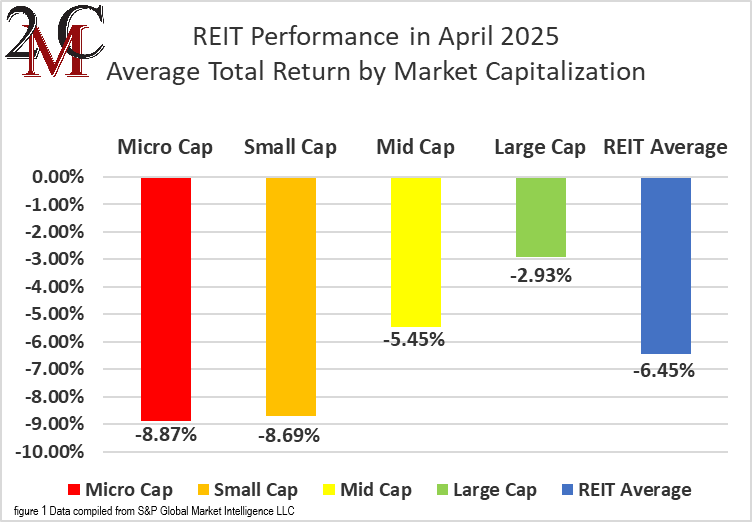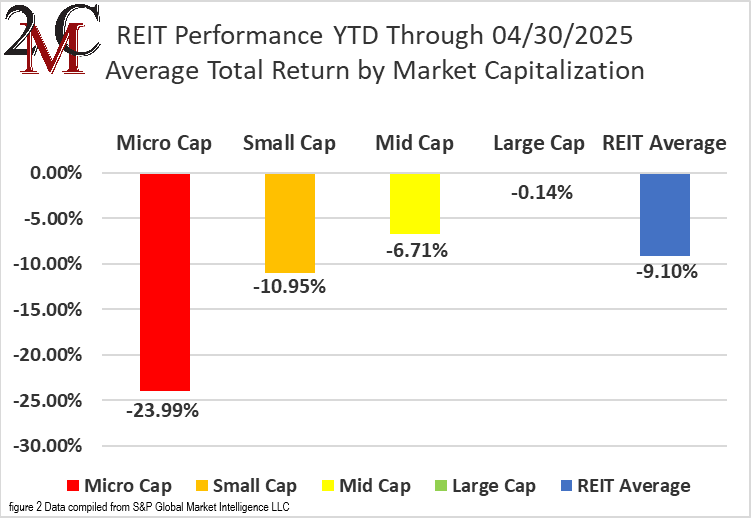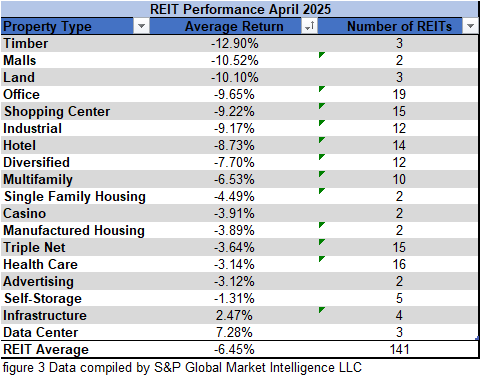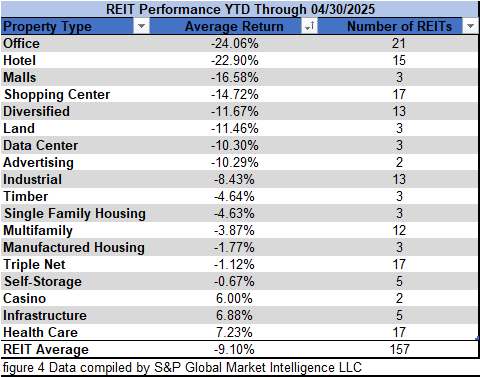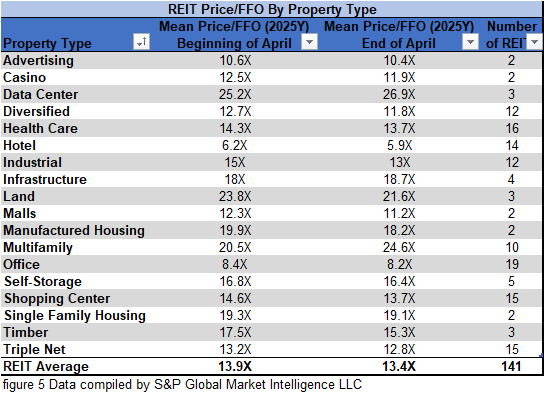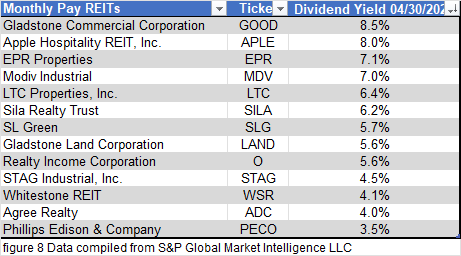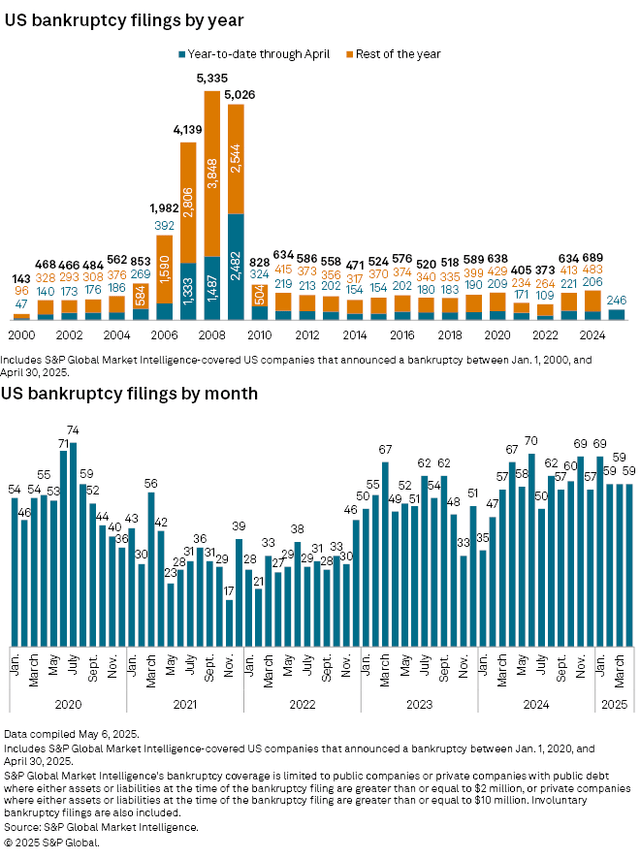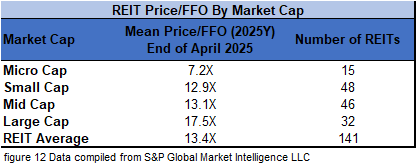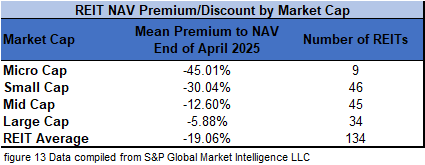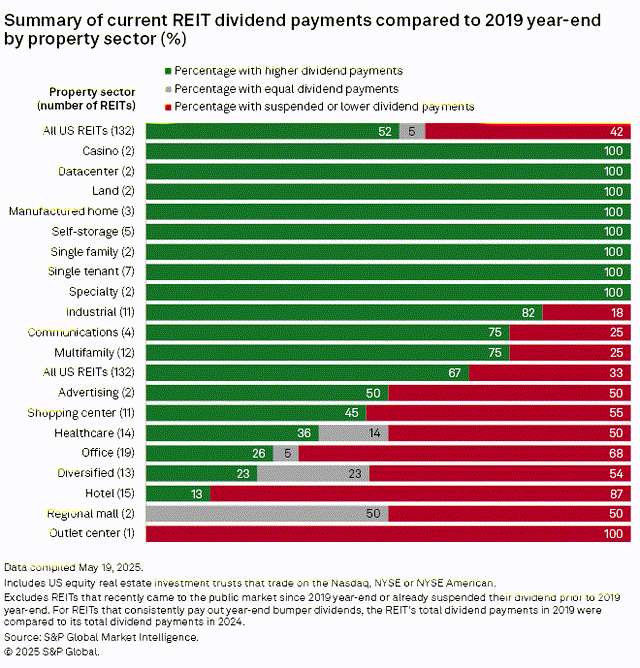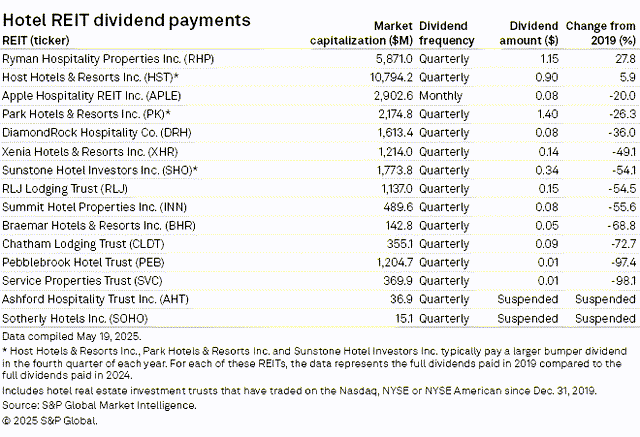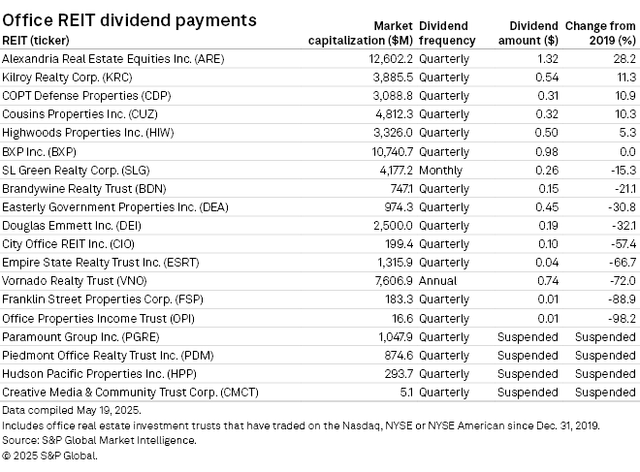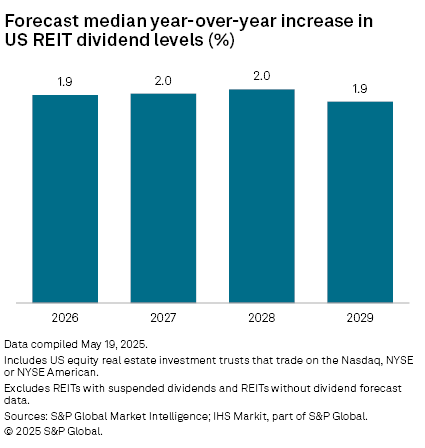The State of REITs: May 2025 Edition
- The REIT sector saw another month of red in April (-6.45%) and REITs now average a -9.10% return over the first 4 months of the year.
- Micro cap (-8.87%) and small cap REITs (-8.69%) endured bigger average losses than mid caps (-5.45%) and large caps (-2.93%).
- 62% of REIT securities had a negative total return in April.
- 83% of REIT property types averaged negative total returns in April. Timber (-12.90%) and Mall REITs (-10.52%) averaged the biggest declines, while Data Center (+7.28%) and Infrastructure REITs (+2.47%) finished April in positive territory.
- The average REIT NAV discount widened from -14.81% to -18.93% during April. The median NAV discount also widened from -17.43% to -22.07%.
REIT Performance
REITs fell further into the red in 2025 during a tough April selloff with a -6.45% average total return. The REIT sector badly underperformed the broader market, falling far short of the Dow Jones Industrial Average (-3.1%), S&P 500 (-0.7%), and NASDAQ (+0.9%). The market-cap-weighted Vanguard Real Estate ETF (VNQ) handily outpaced the average REIT again in April (-2.44% vs. -6.45%) and has massively outperformed year-to-date (+0.19% vs. -9.10%). The spread between the 2025 FFO multiples of large cap REITs (17.5x) and small cap REITs (12.9x) narrowed in March as multiples contracted 0.6 turns for large caps but held steady for small caps. Investors currently need to pay an average of 35.7% more for each dollar of FFO from large cap REITs relative to small cap REITs. In this monthly publication, I will provide REIT data on numerous metrics to help readers identify which property types and individual securities currently offer the best opportunities to achieve their investment goals.
Micro cap REITs (-8.87%) underperformed their larger peers for the 6th straight month. Large caps (-2.93%) continued to outperform both mid caps (-5.45%) and small caps (-8.69%) in April. During the first four months of 2025, large cap REITs outperformed small caps by 1081 basis points.
16 out of 18 Property Types Averaged Negative Returns in April
Only 11.11% of REIT property types averaged a positive total return in April. There was a 20.17% total return spread between the best and worst performing property types. Data Centers (+7.28%) and Infrastructure (+2.47%) were the only property types in positive territory in April. Timber (-12.90%), Mall (-10.52%), and Land REITs (-10.10%) averaged double-digit declines.
Office (-24.06%) and Hotel REITs (-22.90%) significantly underperformed over the first four months of 2025. Health Care (+7.23%), Infrastructure (+6.88%) and Casinos (+6.00%) were the only three property types to average positive total returns year-to-date.
The REIT sector as a whole saw the average P/FFO (2025Y) decrease 0.5 turns in April from 13.9x down to 13.4x. 16.7% of property types averaged multiple expansion, and 83.3% averaged multiple contraction in April. Data Centers (26.9x), Multifamily (24.6x), Land (21.6x), Single Family Housing (19.1x), and Infrastructure (18.7x) currently trade at the highest average multiples among REIT property types. Hotels (5.9x) and Office (8.2x) are the only property types that average single-digit FFO multiples.
Performance of Individual Securities
Equity Commonwealth (EQC) has delisted from the NYSE with a last trading day of April 21st. EQC paid out a final cash liquidating distribution of $1.60 per share on April 22nd, which followed a $19.00/share cash liquidating distribution in December.
Digital Realty Trust (DLR) (+12.04%) achieved a strong gain in April as they raised guidance and outlined an ambitious growth plan for the year. Despite outpacing all other REITs in April, DLR is still in the red year-to-date with a -8.72% total return in 2025.
Wheeler REIT (WHLR) (-63.61%) was yet again the worst performing REIT in April and has already plummeted a disastrous -98.29% in just the first 4 months of 2025. This collapse mirrors Wheeler’s -98.47% 2024 return as the freefall continues.
Only 15.38% of REITs had a positive total return in April. REITs have averaged a -9.10% year-to-date total return in 2025, which was a bit worse than the -7.65% return for the REIT sector over the first 4 months of 2024.

Dividend Yield
Dividend yield is an important component of a REIT’s total return. The particularly high dividend yields of the REIT sector are, for many investors, the primary reason for investment in this sector. As many REITs are currently trading at share prices well below their NAV, yields are currently quite high for many REITs within the sector. Although a particularly high yield for a REIT may sometimes reflect a disproportionately high risk, there exist opportunities in some cases to capitalize on dividend yields that are sufficiently attractive to justify the underlying risks of the investment. I have included below a table ranking equity REITs from highest dividend yield (as of 4/30/2025) to lowest dividend yield.

Although a REIT’s decision regarding whether to pay a quarterly dividend or a monthly dividend does not reflect on the quality of the company’s fundamentals or operations, a monthly dividend allows for smoother cash flow to the investor. Below is a list of equity REITs that pay monthly dividends ranked from highest yield to lowest yield.
Dividend News
5 REITs announced increases to their dividend in April, 4 of which pay quarterly dividends and 1 of which pays monthly. Tanger (SKT) (+6.4%) announced the largest dividend raise followed by UMH Properties (UMH) (+4.7%) and Medalist Diversified REIT (MDRR) (+3.8%). In total, 40 REITs increased their dividend during the first four months of 2025.
Economic Health
The number of corporate bankruptcies remained elevated and flat month over month in April. There were more filings year-to-date in 2025 than in the first 4 months of any other year since 2010. There have been 19.4% more bankruptcy filings over the first 4 months of 2025 than during the same period in 2024.
Valuation
REIT Premium/Discount to NAV by Property Type
Below is a downloadable data table, which ranks REITs within each property type from the largest discount to the largest premium to NAV. The consensus NAV used for this table is the average of analyst NAV estimates for each REIT. Both the NAV and the share price will change over time, so I will continue to include this table in upcoming issues of The State of REITs with updated consensus NAV estimates for each REIT for which such an estimate is available.
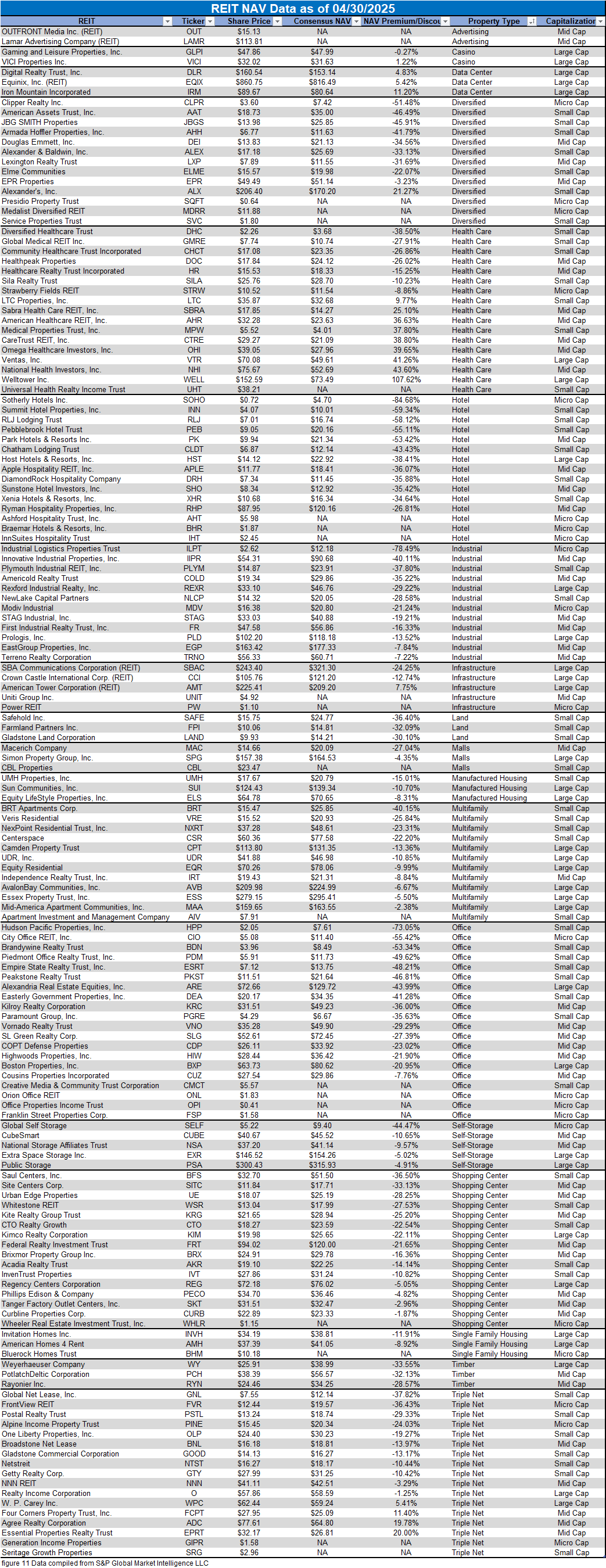
Takeaway
The large cap REIT premium (relative to small cap REITs) narrowed in April and investors are now paying on average about 36% more for each dollar of 2025 FFO/share to buy large cap REITs than small cap REITs (17.5x/12.9x – 1 = 35.7%). As can be seen in the table below, there is presently a strong positive correlation between market cap and FFO multiple.
The table below shows the average NAV premium/discount of REITs of each market cap bucket. This data, much like the data for price/FFO, shows a strong, positive correlation between market cap and Price/NAV. The average large cap REIT (-5.88%) trades at a single-digit discount to NAV and mid cap REITs (-12.60%) trade at a low double-digit discount. Small cap REITs (-30.04%) trade at just over 2/3 of NAV while micro caps (-45.01%) trade slightly north of half of their respective NAVs.
Much of the REIT Sector Has Still Not Fully Recovered from the Impact of COVID-19 and Lockdowns
Although the entire economy was impacted by Covid-19 and the corresponding government-imposed lockdowns, multiple real estate property types got hit particularly hard. Most notably, hotels were impacted by reduced travel and cancelled events, office leasing was dealt a devastating blow by the shift to work-from-home and some retail was even banned from opening their doors to customers for a period of time.
One of the most direct victims of the economic hit REITs took was dividend payments. Even after multiple years of post-lockdown recovery, 42% of REITs still pay a lower dividend than they did pre-Covid and in some cases still have a suspended dividend. 50% or more of REITs still have a lower or suspended dividend in Hotels, Malls, Diversified, Office, Healthcare, Shopping Centers and Advertising.
Only 2 hotel REITs have raised their dividend payments to greater than the level they were in 2019, Ryman Hospitality Properties (RHP) (+27.8%) and Host Hotels & Resorts (HST) (+5.9%). Others have cut their dividends by 20% – 98.1% or, in the case of Sotherly Hotels (SOHO) and Ashford Hospitality Trust (AHT), have suspended and not yet reinstated their dividends.
4 office REITs have suspended and not yet reinstated their dividends: Paramount Group (PGRE), Piedmont Office Realty Trust (PDM), Hudson Pacific Properties (HPP) and Creative Media & Community Trust (CMCT). Other Office REITs have cut their dividends anywhere from 15.3% to 98.2%. Not all Office REITs are the same, however, as Alexandria Real Estate Equities (ARE), which focuses on high quality life science office space, has steadily increased earnings and raised their dividend by 28.2% over that same period.
Not all REITs have struggled to maintain their dividends, however, with many able to aggressively increase their dividends over the same period. The largest dividend hikes came from American Homes 4 Rent (AMH) (+500%), SBA Communications (SBAC) (+200%) and Rexford Industrial Realty (REXR) (+132.4%). Industrial accounts for 6 of the 10 REITs with the greatest dividend expansion since the end of 2019.
Equity REITs that currently pay a dividend are forecast by S&P Global Market Intelligence dividend analysts to increase their dividends steadily through 2029. This stable dividend growth is projected to be within a range or 1.9%-2.0% per year. Steady dividend growth can have a snowball effect, building income in a portfolio. Active investors have the opportunity to potentially achieve higher portfolio income growth, however, with heavier weightings in higher dividend growth REITs.
Important Notes and Disclosure
All articles are published and provided as an information source for investors capable of making their own investment decisions. None of the information offered should be construed to be advice or a recommendation that any particular security, portfolio of securities, transaction, or investment strategy is suitable for any specific person. The information offered is impersonal and not tailored to the investment needs of any specific person.
We cannot determine whether the content of any article or recommendation is appropriate for any specific person. Readers should contact their financial professional to discuss the suitability of any of the strategies or holdings before implementation in their portfolio. Research and information are provided for informational purposes only and are not intended for trading purposes. NEVER make an investment decision based solely on the information provided in our articles.
We may hold, purchase, or sell positions in securities mentioned in our articles and will not disclose this information to subscribers, nor the time the positions in the securities were acquired. We may liquidate shares in profiled companies at any time without notice. We may also take positions inconsistent with the information and views expressed on our website.
We routinely own and trade the same securities purchased or sold for advisory clients of 2MCAC. This circumstance is communicated to our clients on an ongoing basis. As fiduciaries, we prioritize our clients’ interests above those of our corporate and personal accounts to avoid conflict and adverse selection in trading these commonly held interests.
Past performance does not guarantee future results. Investing in publicly held securities is speculative and involves risk, including the possible loss of principal. Historical returns should not be used as the primary basis for investment decisions. Although the statements of fact and data in this report have been obtained from sources believed to be reliable, 2MCAC does not guarantee their accuracy and assumes no liability or responsibility for any omissions/errors
Commentary may contain forward-looking statements that are by definition uncertain. Actual results may differ materially from our forecasts or estimations, and 2MCAC and its affiliates cannot be held liable for the use of and reliance upon the opinions, estimates, forecasts, and findings in this article.
Through October 2021, The State of REITs was published exclusively on Seeking Alpha by Simon Bowler, Sector Analyst at 2nd Market Capital Services Corporation (2MCSC). Editions subsequent to October 2021 will be published on this website in addition to other platforms that may include Seeking Alpha. 2MCSC was formed in 1989 and provides investment research and consulting services to the financial services industry and the financial media. 2MCSC does not provide investment advice. 2MCSC is a separate entity but related under common ownership to 2nd Market Capital Advisory (2MCAC), a Wisconsin registered investment advisor. Simon Bowler is an investment advisor representative of 2MCAC. Any positive comments made by others should not be construed as an endorsement of the author's abilities to act as an investment advisor.
S&P disclosure: S&P Global Market Intelligence LLC. Contains copyrighted material distributed under license from S&P.
Discover more from 2nd Market Capital Advisory Corp
Subscribe to get the latest posts sent to your email.
